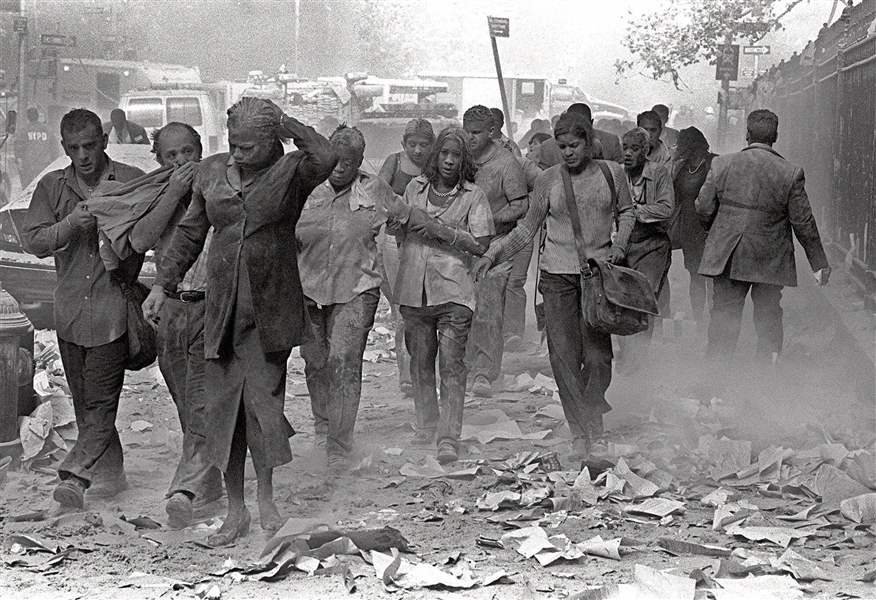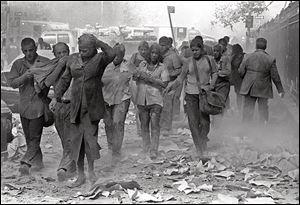
A decade after 9/11, more questions than answers about health problems blamed on WTC dust
9/11/2011
People covered in dust walk over debris near the World Trade Center in New York in this Sept. 11, 2001, file photo.
ASSOCIATED PRESS

Firefighters make their way over the ruins of the World Trade Center through clouds of smoke at ground zero in New York, in this Oct. 11, 2001 file photo.
NEW YORK — Like a lot of New Yorkers who spent time near the smoking ruins of the World Trade Center, Lorraine Ashman needs to take a deep breath before listing all the health problems that have afflicted her over the past decade.
First she got bronchiolitis and a constant cough that lasted for months. Then there were sinus infections, nine so far. She had pneumonia. She's developed immune system problems, vitamin deficiencies and a sensitivity to gluten. She had acid reflux so bad it damaged the lining of her esophagus.
"I've just been sick nonstop," she said. "Being on antibiotics 12 months out of the year is an insane way to live ... I take 17 pills in the morning and six at night."
Ashman, 57, blames it all on the sooty air she inhaled in the two months she worked as a volunteer near ground zero.
Science, however, is less sure.
A decade's worth of study has answered only a handful of questions about the hundreds of health conditions that people like Ashman suspect are related to the tons of gray dust that fell on the city when the trade center collapsed.
While people have blamed everything from strange rashes to skin cancer on the dust, the list of illnesses even tentatively linked to the disaster is short.
Researchers have documented increased asthma rates among people exposed to the dust. Unusually high numbers of people have been diagnosed with chronic sinus problems, or inflammation of their nasal passages that makes their nose run constantly and causes a drippy cough. Many have also developed chronic heartburn caused by a stomach acid condition known as Gastroesophageal reflux disease.
Doctors at clinics that treat ground zero workers and volunteers believe that exposure to the dust, which was made up of tons of pulverized concrete, glass and other building materials, may have irritated some people's upper respiratory systems so much that many still haven't recovered.
"We think it has set up a cycle of chronic irritation," said Dr. Michael Crane, director of the World Trade Center Medical Monitoring and Treatment Program at Mt. Sinai Medical Center. "It's a very disturbing condition. It keeps people up at night."
Luckily, he said, those symptoms are also highly controllable. Patients can use antihistamine and steroid sprays and a saline rinse to ease their discomfort. Asthma isn't curable, but can be controlled through medication and quick-relief inhalers. A smaller group of people have had surgery to relieve sinus problems.
For many of the thousands getting treatment, however, fear runs deep. They aren't worried about a nagging cough, or a frequent runny nose. They are worried about cancer.

People covered in dust walk over debris near the World Trade Center in New York in this Sept. 11, 2001, file photo.
And here, experts said, evidence of a tie has been lacking.
Hundreds of people exposed to trade center dust have, indeed, gotten cancer, and many have died, but that hasn't surprised doctors. Cancer is a leading killer of people in the U.S., even among people in their 40s. Many of the cancers now afflicting people who spent time on the debris pile can develop over decades, meaning the disease could have been simmering away unnoticed in their bodies for many years before 9/11.
Two new studies published Friday in the medical journal, The Lancet, failed to find a significant increase in cancer, or other deadly illnesses, among people exposed to the dust.
Fire department researchers who studied cancer rates in 9,000 exposed firefighters found only four more cases of the illness than they would normally expect. Experts said that kind of increase is insignificant, though health advocates said they did see some worrisome trends in the data, including an unexpected number of a few rare types of the disease, including thyroid cancer.
Another study of 42,000 people in a World Trade Center health registry found that, so far, they have had a better mortality rate than the general public. It said 790 people in the study group had died as of 2009, about 43 percent fewer than expected. Researchers said that is probably because the study group tended to be comprised of people who were healthier than the general public before 9/11.
Researchers don't know whether trade center dust put large numbers of people at risk for severe lung conditions like pulmonary fibrosis, either. There have been some studies suggesting a small excess in cases of the immune system problem sarcoidosis among firefighters, but the number of cases has run in the dozens. People who were at ground zero have complained of kidney problems, liver problems, chronic headaches, stroke, various types of chemical poisoning, strange rashes — none of which have been connected to the dust.
Doctors can't agree on many cases.
In the most famous case, a medical examiner in New Jersey blamed the 2006 death of disabled New York City police detective James Zadroga on tiny World Trade Center particles embedded in his lungs, only to have that finding challenged by New York City's medical examiner, who concluded that the particles were caused by prescription drug abuse.
Sorting fact from fear is only going to get tougher over the next decade.
The median age for a first responder at ground zero on 9/11 was 38, meaning a majority of these men and women are now nearing 50, an age when all manner of health problems begin to emerge.
Some things about the illnesses people are getting have puzzled scientists. Many of the people now experiencing sinus problems and asthma-like symptoms said they felt absolutely fine for years after their exposure to the dust.
They weren't coughing. They could run up a flight of stairs without getting winded. Then, sometimes quite suddenly, their condition came out of nowhere.
Crane said the Mt. Sinai clinic is still getting about 100 new patients every month, and he doesn't think they are fakers, or people overreacting to intense media coverage of the issue. They are almost all people, he said, who are initially reluctant to consider the idea that their persistent illnesses might be linked to time they spent at the World Trade Center.
Caught in the middle of the search for scientific truth are people like Stephen Petrovich, a 60-year-old Ukrainian Orthodox Church priest from Huron, Ohio, who says he drove to New York after the terror attacks and spent a little over two weeks at ground zero volunteering as a chaplain.
Today, he is in a hospice, wheezing and short of breath from a lung condition that he believes was caused by breathing smoke at the site.
"There is nothing they can do. I was told I've got 18 months. It could be 18 months. It could be less. It could be two years. It just depends on how fast this goes through me," he said. "I just hope to God that I die in my sleep."
There are others who endure a different kind of suffering — nightmares, depression and anxiety. Post-traumatic stress disorder, along with common respiratory ailments, is what scientists can most strongly link to their experience at the trade center site. New York City's health commissioner, Thomas Farley, said researchers estimate that as many as 19 percent of the people enrolled in the city's trade center health registry have PTSD.
He said those psychological problems, in the end, could be just as serious a public health problem as physical issues caused by the dust.
The sick include more than 10,000 construction workers, police officers, firefighters and others who spent time clearing ground zero of debris who sued the city and contractors over their illnesses; a legal settlement worth well over $700 million was reached this year.
U.S. Rep. Carolyn Maloney, a New York Democrat who helped lead a push to create a multibillion-dollar health care and compensation package for ground zero workers last year, said that everywhere she goes, she hears stories from people whose health has mysteriously deteriorated.
"I've seen very strong, healthy ironworkers ... they are strong people. Big strong people. And over the years I've seen them just shrink and shrink," she said.
There has been a lot of talk about adding cancer to the list of illnesses covered by the World Trade Center health bill — one that was named after Zadroga.
Maloney said she understands that there needs to be a scientific basis to expand the range of diseases, but she notes that scientists and politicians debated for decades over the health risks of smoking.
"There has to be a scientific basis," she said. "But we also don't want to have to wait too long to help people who are suffering."